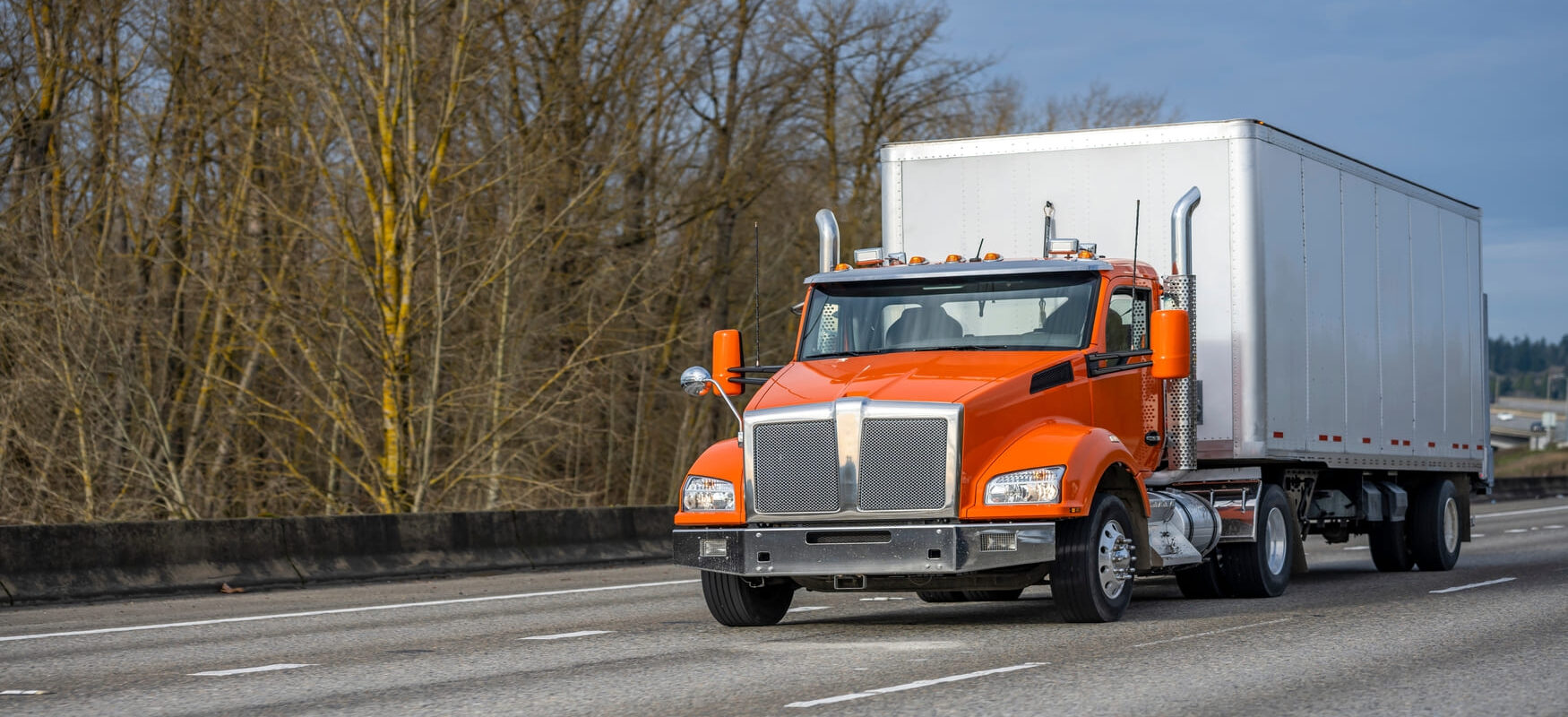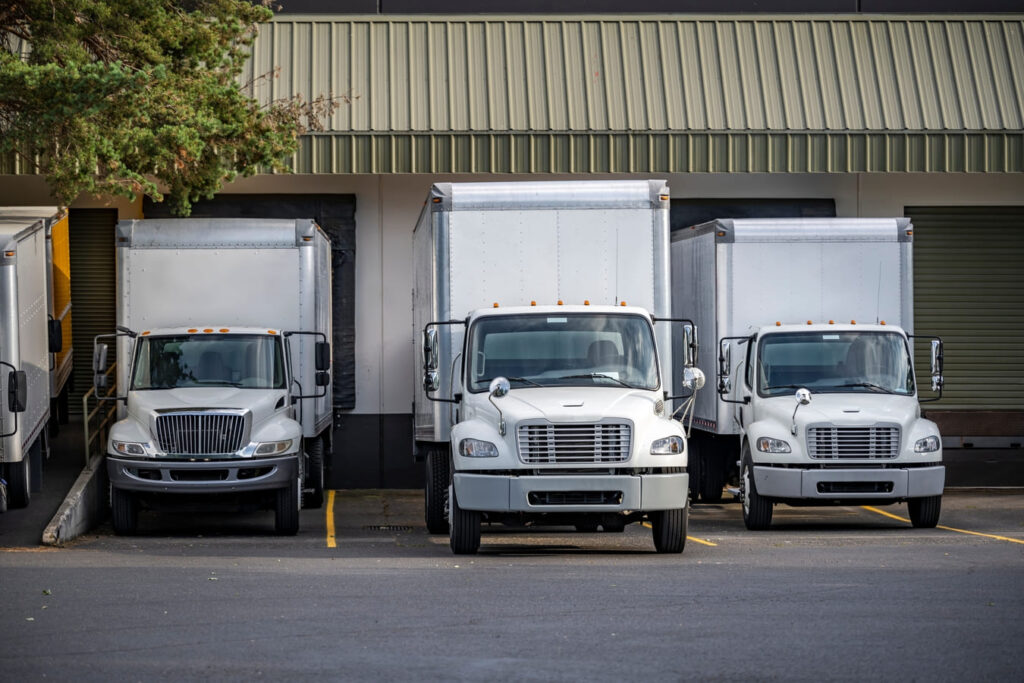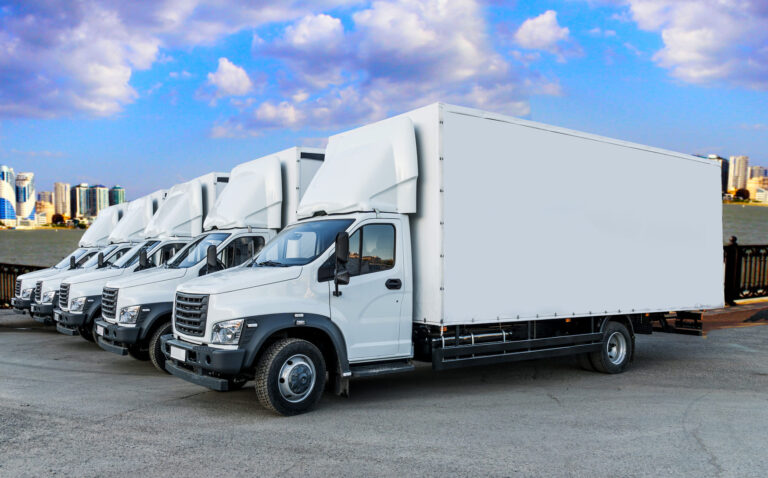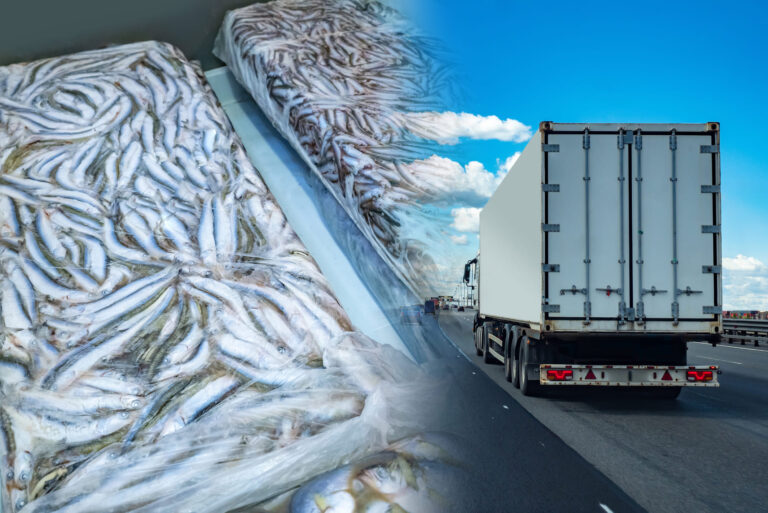Straight Truck Guide: Dimensions, Weight Limits & Choosing the Right Truck

A straight truck, sometimes called a box truck, is a medium‑duty vehicle in which the cab and cargo body are built on a single frame. Unlike tractor‑trailers, the cargo area is permanently attached to the chassis, so drivers do not pull a separate trailer. Straight trucks (class‑7 vehicles) connect all axles to one frame and have GVWRs up to roughly 33,000 lb. They’re widely used for local deliveries, moving services and final‑mile distribution because they’re easier to maneuver in urban environments and generally cost less to operate than larger semi‑trucks.
Key Takeaways
- A straight truck is a single‑frame vehicle; the cab and cargo box cannot detach like a semi‑trailer.
- The terms straight truck and box truck are often used interchangeably; box trucks are simply straight trucks with enclosed cargo boxes.
- Common straight‑truck lengths range from 10 ft to 26 ft, with payloads from 3,000 lb (small) up to 12,000 lb or more (large).
- Height matters: interior heights are around 8 ft to 9 ft and exterior clearance heights range 10 ft–13.5 ft depending on the truck size.
- A CDL is not usually required for straight trucks under 26,000 lb GVWR, making it easier to hire drivers.
- Choosing the right straight truck involves matching cargo size, payload needs, loading dock height and regulatory requirements to the truck’s specifications.
What is a Straight Truck?
A straight truck is a medium-duty truck where the cab and cargo body share the same frame. Unlike a tractor-trailer (where the trailer detaches), a straight truck’s cargo box is fixed to the chassis. Because of this design, straight trucks tend to be more maneuverable in cities. They typically range 10–26 feet in length with gross vehicle weight ratings (GVWR) from about 10,001 to 33,000 pounds. These vehicles are ideal for local deliveries, moving services, and many other transport tasks in logistics.
In practice, the terms straight truck and box truck are often used interchangeably (the term “straight body truck” is another synonym). A box truck is essentially a type of straight truck , both have an enclosed rectangular cargo area on a single frame. The phrase “straight box truck” simply refers to a straight truck with a box-shaped cargo body. In short, a straight box truck is just a straight truck (also called a box truck) built as one unit.
Straight Truck vs Box Truck
When comparing straight trucks and box trucks, remember they belong to nearly the same category. A box truck is simply a straight truck with a fully enclosed cargo box. Both have similar designs and uses. The key difference is terminology: straight truck emphasizes the single-frame chassis, while box truck highlights the cube-shaped cargo area. In other words, a box truck is a straight truck, many people use the terms synonymously. For shippers and logistics managers, the important point is that these terms overlap. Choosing between them comes down to capacity and use case, not any major technical differences.
Straight Truck Sizes, Dimensions & Capacities
Choosing the correct truck size ensures your freight fits, your drivers meet regulatory requirements and you avoid clearance issues on the road. Straight trucks vary by length, height, GVWR and payload capacity.
Typical Lengths
- Small straight trucks (10–16 ft): Best for parcel deliveries, local routes, and light LTL freight. These trucks are highly maneuverable and commonly used in urban environments.
- Medium straight trucks (17–24 ft): Often used for furniture moving, retail deliveries or regional freight. Payload capacity typically 7,000–10,000 lb.
- Large straight trucks (26 ft): Provide maximum enclosed cargo space for high-volume or commercial shipments. These trucks are commonly used for full loads, warehouse transfers, and large deliveries.
Height & Width
- Interior height: Most straight trucks offer an interior cargo height of approximately 8–9 feet, allowing operators to load stacked pallets and tall freight safely.
- Exterior clearance height: Exterior height generally ranges between 10 and 13.5 feet, depending on truck size and roof equipment. Larger 26-foot straight trucks typically fall at the higher end of this range.
- Width: Most straight trucks measure 6–8 feet wide, while larger or three-axle models may reach up to 8.5 feet, which is the standard legal road width in many regions.
GVWR & Payload Capacity
The gross vehicle weight rating (GVWR) includes the vehicle’s own weight plus cargo, passengers and fuel. It determines whether a CDL is required.
| Truck Size | Cargo Length | GVWR | Payload Capacity | Common Uses |
|---|---|---|---|---|
| Small Straight Truck | 10–14 ft | 10,000–16,000 lbs | 3,000–6,000 lbs | Small parcel deliveries, light cargo transport |
| Medium Straight Truck | 16–20 ft | 16,000–26,000 lbs | 6,000–12,000 lbs | Furniture moving, appliance transport, retail deliveries |
| Large Straight Truck | 22–26 ft | 26,000–33,000 lbs | 12,000–15,000 lbs | Commercial moving, logistics, heavy goods transport |
Note: Some truck rental companies offer CDL and non‑CDL versions. Non‑CDL straight trucks must stay below 26,000 lb GVWR.
Advantages of a Straight Truck
Straight trucks offer several benefits that make them an excellent choice for many businesses:
1. Easy Maneuverability
Compared to semi-trucks and tractor-trailers, straight trucks are easier to navigate, especially in urban areas with tight streets and heavy traffic. Their smaller turning radius allows for better handling in parking lots, warehouses, and loading docks. This maneuverability is a huge advantage for last-mile deliveries in cities.
2. Cost-Effective Operation
Straight trucks tend to have lower operating costs compared to larger trucks. Benefits include:
- Better fuel efficiency than tractor-trailers.
- Lower maintenance costs due to their simpler design.
- Reduced toll fees since they are typically lighter and smaller.
3. No CDL Requirement for Smaller Models
Many straight trucks, especially those with a GVWR under 26,000 lbs, do not require a commercial driver’s license (CDL), making it easier to hire drivers. However, larger models exceeding 26,000 lbs may require a CDL depending on local regulations.
4. Faster Loading and Unloading
Straight trucks often come equipped with features that speed up loading and unloading of cargo, such as:
- Roll-up rear doors for quick access to the cargo area.
- Lift gates for easier handling of heavy items (allowing the truck to load/unload without a loading dock).
- Side doors for convenient multi-stop deliveries, enabling the driver to access cargo from the side.
These features enhance efficiency in warehouses, retail stores, and on delivery routes by reducing the time and labor needed to handle freight.
5. Versatile Applications
Straight trucks can be adapted for multiple industries:
- Retail and E-commerce: Transporting products to stores or distribution centers.
- Moving Services: Ideal for household and office relocations.
- Food Industry: Refrigerated straight trucks (reefers) keep perishable goods fresh during transit
- Construction: Flatbed straight trucks can haul equipment and building materials.
6. Urban Delivery Compatibility
In many cities, large semi-trucks face weight or size restrictions. Straight trucks often fall below these limits, making them an ideal alternative for urban freight delivery. Their more compact size allows businesses to navigate residential streets, alleys, and low-clearance areas where tractor-trailers cannot fit. This dock-high straight truck design (with ~48″ deck height matching docks) also enables easy loading at urban warehouses and storefronts.
7. Increased Driver Availability
Since smaller straight trucks do not require a CDL, businesses can hire a broader range of drivers, reducing the time and cost needed for recruitment and training.
Types of Straight Trucks
Common types of straight trucks include:
- Box Trucks: These have a fully enclosed, box-shaped cargo area. Box trucks (a typical straight truck) are ideal for transporting furniture, appliances, moving boxes, and other items that need protection from weather. Most rental moving trucks (like U-Haul trucks) are box trucks.

- Refrigerated Straight Trucks (Reefers): Equipped with built-in refrigeration units, these trucks transport perishable goods at controlled temperatures (commonly used for food delivery and pharmaceuticals).
- Flatbed Trucks: Built with an open flat platform instead of walls, flatbed straight trucks are useful for carrying oversized or irregularly shaped items such as construction materials or machinery. They allow loading/unloading from the sides or above (e.g. by crane).
- Tanker Trucks: Designed for transporting liquids or gases, tanker straight trucks have cylindrical tanks mounted on the chassis. They’re commonly used for fuel delivery, water transport, or chemicals, in cases where a full semi-tanker is not needed.
- Dump Trucks: Equipped with hydraulic mechanisms, dump trucks allow easy unloading by lifting their cargo beds at an angle to dump contents onto the ground, ideal for hauling loose materials like sand, gravel, or debris from construction sites.
Each of these is a straight truck (single-frame design) adapted for specific cargo or industry needs. Choosing the right type depends on what you need to haul – for example, use a refrigerated straight truck for frozen foods, a flatbed for large equipment, or a box truck for general freight.
How to Choose the Right Straight Truck
Selecting a straight truck involves more than just picking a size off the lot. To ensure operational efficiency and legal compliance, consider the following steps:
- Assess Your Cargo & Volume: Determine the size, weight and fragility of your shipments. Small trucks handle 3,000–6,000 lb payloads, while large 26‑ft models can haul 10,000–12,000 lb. Analyze average shipment volume and growth projections.
- Check Dimensions & Clearance: Verify that the truck’s length fits your loading dock and that the exterior height (10–13.5 ft) clears bridges, parking garages and drive‑thru canopies on your routes. Consider interior height (around 8 ft) for standing cargo or tall equipment.
- Match GVWR to CDL Requirements: If your drivers lack commercial driver’s licenses, stick to trucks below 26,000 lb GVWR. Larger GVWRs or towing additional trailers may require a Class B or Class A CDL.
- Consider Specialized Features: Decide if you need liftgates, refrigeration units, side doors, e‑track systems or dock‑high decks. These features can improve efficiency but add cost.
- Test & Budget: Whenever possible, test drive the truck to assess maneuverability and comfort. Compare purchase, rental or leasing costs, factoring in fuel economy and maintenance.
By aligning the truck’s capabilities with your shipment characteristics and delivery environment, you can choose a vehicle that maximizes efficiency and keeps costs under control.
Conclusion
Straight trucks—especially box trucks—are indispensable tools for local and regional freight. With their single‑frame design, moderate lengths (10–26 ft), interior heights around 8 ft and payload capacities up to 12,000 lb these vehicles bridge the gap between cargo vans and heavy tractor‑trailers. They’re ideal for shippers and carriers who need a maneuverable, cost‑effective solution for last‑mile deliveries, moving services and mid‑range freight. Understanding the dimensions, weight limits and regulatory considerations will help you select the right straight truck and keep your logistics operations running smoothly.
Frequently Asked Questions (FAQ) – OLIMP Warehousing
Q: How long is a straight truck?
Straight trucks range 10–26 ft in length. Small straight trucks are about 10–16 ft, while large straight trucks for moving and freight are 22–26 ft. A 26 ft straight truck is the longest standard size.
Q: Is a straight truck the same as a box truck?
Yes. A box truck is a type of straight truck, both have the cab and cargo body on one frame. A “26-foot straight truck” and a “26-foot box truck” mean the same vehicle.
Q: What’s the best straight truck for hauling furniture?
The best choice is an enclosed box straight truck. Mid-size (16–20 ft) works for local furniture delivery, while a 24–26 ft dock-high straight truck with a lift gate is best for full home or showroom furniture moves.
Q: What is the length of a standard 26 ft straight truck?
A 26 ft straight truck has a 26-ft cargo box. Including the cab, the total straight truck length is usually 30–33 ft. Standard width is ~8 ft, with an interior height of ~8 ft.
Q: What is a dock-high straight truck?
A dock-high straight truck has a deck height of 48–52 inches, the same as warehouse docks. Large box straight trucks (24–26 ft) are usually dock-high, making loading fast and efficient.
Q: How much weight can a straight truck carry?
Small straight trucks carry about 3,000–6,000 lbs, medium 7,000–12,000 lbs, and 26 ft large straight trucks can haul 10,000–15,000 lbs. Max weight depends on GVWR (up to 33,000 lbs).
Q: What are typical straight truck sizes and GVWR ratings?
Straight trucks usually range from 10 to 26 feet in length. GVWR typically falls under 26,000 lb for small models and can reach up to 33,000 lb for large straight trucks.
Q: Do I need a CDL to drive different classes of straight trucks?
A CDL is generally not required if the straight truck’s GVWR is under 26,000 lb. Trucks exceeding that limit usually require a Class B CDL, depending on regulations and cargo type.
Q: What are common uses and industries that use straight trucks?
Straight trucks are widely used in retail distribution, food and beverage, manufacturing, construction, and local freight delivery. They are ideal for short-haul, regional, and last-mile transportation.
Q: How do maintenance costs for straight trucks compare to trailers?
Straight trucks typically have lower maintenance and fuel costs than semi trucks because they have fewer components and no detachable trailer. This makes them more cost-effective for local and regional operations.
You may be interested in

Box Truck Sizes: Comparing Length, Volume & Payload
Box trucks (also called cube or straight trucks) have a rectangular cargo box mounted directly on the truck chassis behind the cab. They are the workhorses of logistics, used for local deliveries, moving household goods, and regional freight transport. Box truck sizes vary greatly: typical lengths range from about 10 feet up to 26 feet […]

Full Truckload (FTL) Shipping Services: How It Works, Costs & Use Cases
Full truckload shipping (FTL) is a freight transport mode where one shipper’s cargo occupies an entire truck trailer. In FTL service – also known as FTL trucking or full truckload freight transport – a carrier dedicates a 48′ or 53′ trailer exclusively to one shipment. Unlike less-than-truckload (LTL) shipping (where freight from multiple shippers shares […]

Refrigerated Transportation: Keeping Your Goods Fresh and Safe
In today’s fast-paced supply chain, the demand for refrigerated transportation is higher than ever. Businesses need to move fresh produce, dairy, frozen foods, and pharmaceuticals across long distances while preserving their quality. Refrigerated freight shipping (also known as reefer shipping) provides the solution by using temperature-controlled trucks and containers to keep perishable goods transportation safe […]
Ready to streamline your warehousing needs?
Request a quote today and discover how OLIMP's tailored solutions can optimize your operations